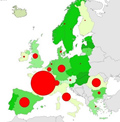 France, Italy, Romania, Spain and Germany account for around half of the population covered by the EU disease surveillance agency but recorded the vast majority of new measles infections.
France, Italy, Romania, Spain and Germany account for around half of the population covered by the EU disease surveillance agency but recorded the vast majority of new measles infections.
In its latest report on health threats, the European Centre for Disease Prevention and Control (ECDC) reveals that the vast majority of European countries recorded more measles cases in 2011 than in 2010.
The ECDC has consistently highlighted the link between lower immunisation rates and rising rates of disease.
Although most parents continue to vaccinate their children, measles is a highly infectious disease and immunisation rates of 95% are required to achieve herd immunity.
While France has been in the spotlight for its high measles rates, Spain and Romania are also attracting unwanted attention. Spanish and Romanian authorities recorded outbreaks during the past week, as did the UK and Sweden.
Twenty-four of the 29 countries reporting to the ECDC recorded more measles cases in 2011 than in 2010. Only Cyprus and Iceland remained measles-free last year.
Meanwhile, the ECDC says it remains concerned by ongoing outbreaks in neighbouring countries, including Ukraine and Russia.
The high number of cases in the western region of Ukraine is of particular concern ahead of the 2012 UEFA European Championships which is expected to attract hundreds of thousands of football fans to Ukrainian cities.
The World Health Organization (WHO) in Europe has told Vaccines Today that tackling measles epidemics will be a major focus of this year’s European Immunization Week which takes place at the end of April.
Europe is committed to eliminating measles by 2015 and has recently set up expert groups to monitor progress. However, ongoing measles outbreaks continue to cast doubts on whether the 2015 target can be met.



